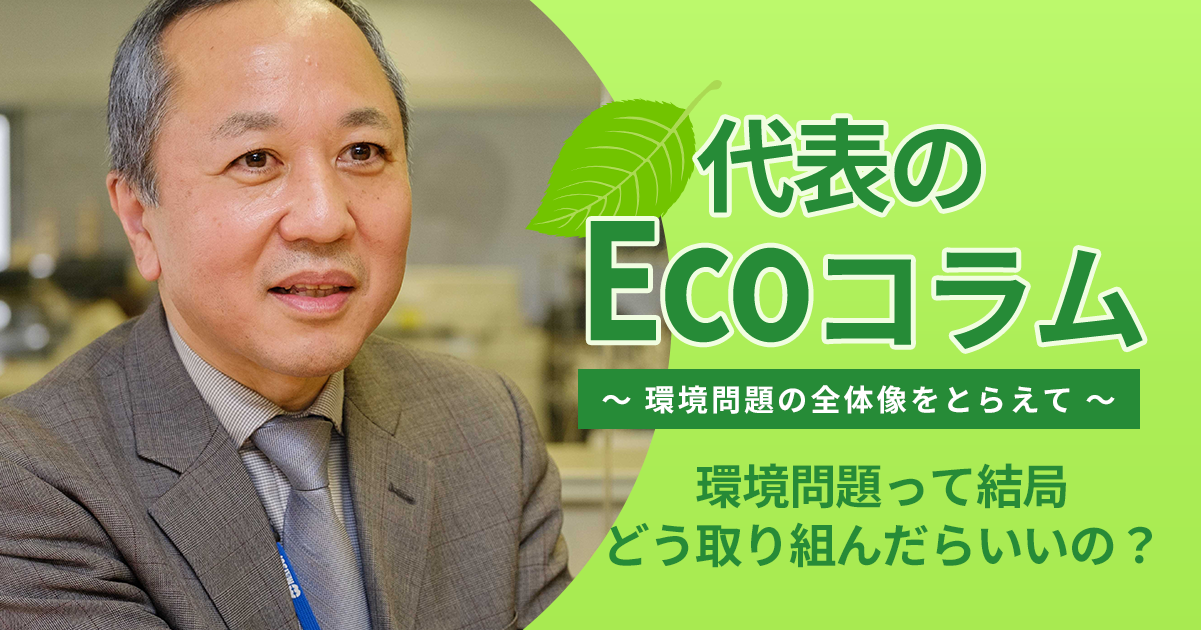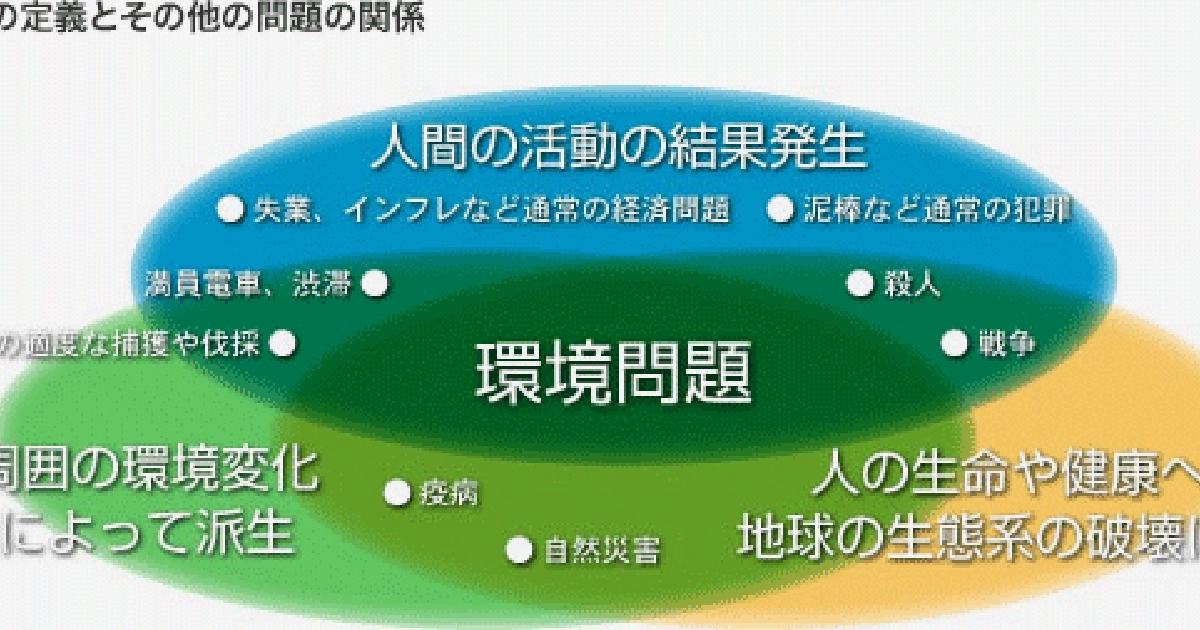Representative's Green Column
9. Utilization and disposal of radioactive materials
2008.11.15
In the last three columns, I mentioned one of the three major environmental issues, "insufficient energy resources, water, and food." Now, I would like to talk about "use and disposal of radioactive materials," which is one of the other three major environmental issues.
When it comes to the use of radioactive materials, there are two major areas of use. One is nuclear power generation and the other is nuclear weapons.
Nuclear weapons are not a major topic here, but at least I think we must avoid spreading them outside of a well-established country with a well-managed system.
Here, I would like to take up nuclear power generation as a major theme, and take up the issue of "power generation" in the sense of utilization and the accompanying "disposal" of radioactive materials.
● Nuclear power generation is now in the limelight.
With rising energy demand, soaring oil prices, and the issue of global warming caused by CO2, nuclear power generation has come into the limelight. Currently, there are concrete plans to build 127 new nuclear power plants in 21 countries around the world. Including the number that has been envisioned in the future, there will be 222 units in 29 countries (based on data from the World Nuclear Association WNA as of December 2007).
I would like to see how much advantage nuclear power generation has in terms of reducing CO2 and responding to increasing energy demand, and conversely, how much risk it poses from the perspective of waste.
● How much CO2 can be suppressed by nuclear power generation?
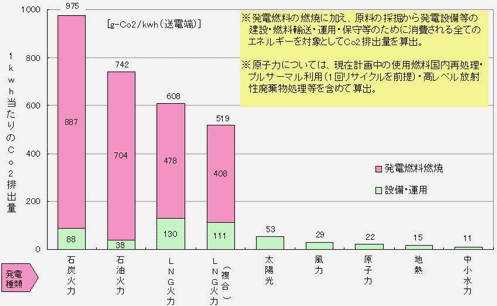
First, let's take a look at how effective nuclear power generation is in controlling the generation of CO2. The amount of CO2 generated varies considerably depending on the method of power generation, but it seems difficult to grasp this accurately. This is because the numbers change depending on the calculation conditions and how to make assumptions. The data below is the latest analysis data from the Central Institute of Power Industry. The data was published on July 10, 2001.
From: https://criepi.denken.or.jp/research/news/pdf/den338.pdf
Looking at this, nuclear power generation is extremely effective in suppressing CO2 generation, and the amount of CO2 generated is less than that of solar power generation and wind power generation.
However, there seems to be some ideas that are not enough. This is because nuclear power is difficult to stop or operate due to fluctuations in the demand for electricity. Nevertheless, the amount of electricity used changes greatly even during the day. In general, electricity is used more during the day than at night. In order to supply Power accordingly, the amount of power generation must be changed. Nuclear power alone cannot cope with such fluctuations. Therefore, when using nuclear power, thermal power generation is generally required together with it to cope with fluctuations. In the end, it is argued that a nuclear and thermal power plant will be needed as a set, and it will be necessary to consider not only the CO2 emissions of nuclear power but also the amount of thermal power.
Overall, nuclear power seems to be quite effective in controlling CO2 emissions, if not as much as in the graph above.
● How much can nuclear power generation alleviate the problem of energy resource shortages?
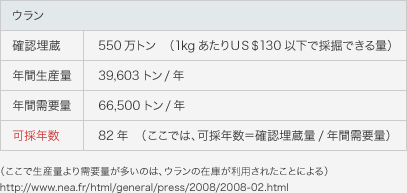
First, we examined the confirmed reserves and recoverable life of uranium resources. The following data is current as of 2007 ("Uranium 2007").
The recoverable life of 82 years may seem like a long time, but considering that the amount of Power by nuclear power generation is about 6% of total energy demand, uranium is a resource that is Emergency small as an energy resource. It can also be said. For example, if we assume that nuclear power will cover 20% of total energy needs, the recoverable life will be 24 years. It can be said that power generation using uranium itself as it is cannot be a powerful solution to the problem of resource shortages.
● To extend the recoverable years of uranium. .. .. Nuclear fuel cycle
The reason that uranium is not so long in harvest is that uranium-235, which is prone to fission, accounts for only about 0.7% of naturally occurring uranium. Approximately 99.3% of naturally occurring uranium is non-fissionable uranium-238, which causes little fission and cannot be used for power generation. However, if this non-burning uranium-238 can be used as fuel, the recoverable years of uranium may increase dramatically. For that purpose, the following two technologies are considered. 1) Plu thermal
Spent nuclear fuel after burning natural uranium in a nuclear reactor (generally, nuclear fuel taken out after burning for 3 years) contains a part of uranium-238 that absorbs neutrons and contains plutonium-239, a substance that easily causes fission. It has been. The flammable plutonium remaining in this spent nuclear fuel is taken out and mixed with uranium to make 4-9% nuclear fuel (MOX fuel). This is used as fuel for ordinary nuclear reactors to generate electricity. This will improve the utilization efficiency of uranium resources by about 25%.
This method has a considerable track record overseas, mainly in France and Germany, and prior agreements have been reached for the implementation of Plu Thermal at four nuclear power plants in Japan as well.
However, this technology alone has the effect of extending the recoverable years of uranium from 80 to 100 years at most. For that reason, there are many areas where safety issues have not yet been fully verified, and there is strong opposition from local residents, so we have to be cautious about implementing it. 2) Fast breeder reactor
A special nuclear reactor called a fast breeder reactor absorbs fast neutrons from burning uranium-235 and plutonium-239 into non-burning uranium-238, converting non-burning uranium-238 into a substance called plutonium-239, which is prone to fission. As a result, uranium, which can only be burned by about 0.7% as it is, can theoretically use about 60% of uranium resources as energy. In other words, it will be possible to extract dozens of times more energy from the same amount of uranium. If this is put into practical use, the recoverable years of uranium will be calculated to exceed 1000 years.
However, this technology is still in the experimental stage, and most of the reactors so far have been closed or Stopping down. There are many countries that stop the development itself because it will cost a huge amount of money for future development. The fast breeder reactor Monju in Japan is currently out of operation Stopping to a fire caused by a sodium leak in 1995. On the other hand, China, Russia, India, etc. seem to be active in development.
Both are called the nuclear fuel cycle because they use spent nuclear fuel and help increase the recoverable years of uranium, but both technologies establish safety and gain people's understanding of the work. There is still a long way to go until we reach the final stage.
● How dangerous is the waste generated by nuclear power generation?
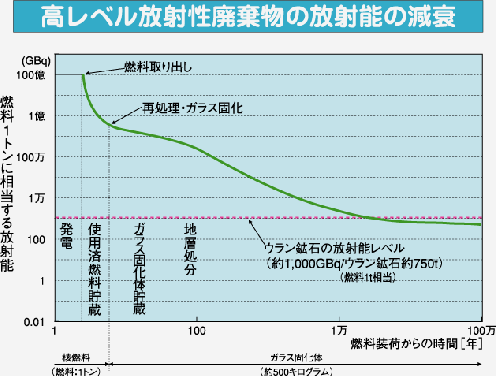
Spent nuclear fuel and the high-level radioactive waste generated in the process of its reprocessing require a long period of more than 10,000 years before it becomes a state that does not affect humans (see the graph below). ). For that long, you need to keep it away from human life and manage it. In other words, it will leave a negative legacy in the future for a dauntingly long period of time. From this point of view, it makes me wonder if we can really do something like this. In particular, plutonium is treated as fuel in the nuclear fuel cycle (pluthermal and fast breeder reactors). This plutonium itself is highly toxic with an annual intake limit of 3/10 million grams per person (Recommended by the International Commission on Radiological Protection), and it can also be used as a raw material for nuclear weapons. The risks posed by the increased use of such fuels can be enormous.
From: Federation of Electric Power Companies of Japan (https://www.fepc.or.jp)
● Summary of nuclear power generation
- It certainly seems to be effective in reducing CO2.
- As for the amount of energy resources, if a fast breeder reactor is not realized, the amount of resources is not so large.
Resources that will disappear in about 80 years even at the current demand level (about 6% of total energy demand).
If demand increases further, it will soon be exhausted. - Plu thermal and fast breeder reactors are being considered to increase the amount of resources.
However, in terms of operational safety, waste disposal and subsequent management, we must be careful in implementing it.
In addition, Plu Thermal increases the amount of resources by only about 25% for the risk.
My own conclusion is that while nuclear power is certainly effective in reducing CO2, it should be avoided as much as possible in the long run. I think it should be used as a limited and short-term bridging energy source. Isn't it better to aim for short-term bridging energy resources without forcibly implementing plu-thermal and fast breeder reactors? I think that methods other than nuclear power generation should be used to reduce CO2 in the long run.
However, on the contrary, in the short term, in the sense of coping with the urgent issues of shortage and soaring of other fossil fuel resources, it will be used for the next 20 to 30 years, although it is limited, while emphasizing safety. I think it is necessary to expand to some extent. After that, I think it is necessary to move to other renewable energy resources as soon as possible.
In the next column, I would like to talk about the most talked-about "rapid warming" among the three major environmental issues.
November 15, 2008 Hironobu Matsui

